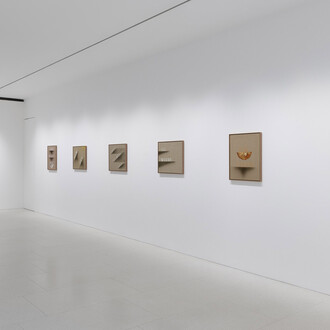Every material has a different density, different weight . . . Every hand squeezes differently. In finding your place in sculpture, you need to find the material that offers you just the right resistance. As it turns out, car metal offers me the correct resistance so that I can make a form—not overform it or underform it.
(John Chamberlain)
Gagosian is pleased to present “ENTIRELYFEARLESS,” an exhibition of metal sculpture by John Chamberlain. Organized in collaboration with the Estate of John Chamberlain, the exhibition is the first in London since “New Sculpture” at Gagosian Britannia Street in 2011.
Chamberlain’s distinctive metal sculptures, often made of crushed and torqued automobile steel, reveal both the stately grace and the expressive plasticity of industrial materials. Exploring the interplay of color, sheen, weight, and balance, Chamberlain taps into the dynamic energy of Abstract Expressionism, the pre-manufactured elements of Pop and Minimalism, and the provocative curves and swells of high baroque.
In this exhibition, large-scale floor sculptures and wall-mounted works made over the course of four decades attest to the seemingly infinite variations of shape and color that Chamberlain explored throughout his career. The centerpiece, ENTIRELYFEARLESS (2009), towers over the viewer, its scrunched red sides bracketed by car bumpers in shiny silver chrome. As fluid as folded drapery, and arresting as a marble monument, it subverts expectations of both abstraction and representation, while exuding a subtle figural quality. In BISHOPBUDD (2009), a nest of twisted metal strips sits atop a huddle of larger contorted planes of black and white steel—the robust, doming form recalling both an elegant tree and a menacing mushroom cloud. Chamberlain fostered a keen appreciation for poetry during the year he spent at Black Mountain College in 1955, and began to consider language as an integral part of his aesthetic approach. His dynamic titles—usually in all caps without spacing—often act as semiotic echoes of the sculptures themselves.
Wanderingwhisper (1986) and MURMUR (2002) show the evolution of Chamberlain’s use of color, with a rosette-like swirl of silver, orange, and red in the former, embellished with occasional scratches and dents, and bold turquoise, green, and purple in the latter, brightly reminiscent of the graphics, graffiti, and decals of the early 2000s. On the wall, the more muted tones of Rebel Ruckus (1975) contrast with GLEAMINGSPOTLIGHT (1992), in which rust peeks out from the twists and folds of polished metal, creating distorted, overlapping reflections.
John Chamberlain was born in Rochester, Indiana, in 1927, and died in New York in 2011. Collections include Tate, London; Stedelijk Museum, Amsterdam; Museum für Moderne Kunst, Frankfurt; Museum moderner Kunst Stiftung Ludwig, Vienna; Museu Coleção Berardo, Lisbon; Museum of Modern Art, New York; Solomon R. Guggenheim Museum, New York; Whitney Museum of American Art, New York; Dia: Beacon, NY; Chinati Foundation, Marfa, TX; Menil Collection, Houston; Los Angeles County Museum of Art; and Museo Jumex, Mexico City. His first retrospective at the Solomon R. Guggenheim Museum, New York (1971) was followed by more than one hundred solo exhibitions, including “John Chamberlain: Sculpture, An Extended Exhibition,” Dia Art Foundation (1982–85); “John Chamberlain: Sculpture, 1954–1985,” Museum of Contemporary Art, Los Angeles (1986); “John Chamberlain,” Staatliche Kunsthalle Baden-Baden, Germany (1991); “John Chamberlain: Sculpture,” Stedelijk Museum, Amsterdam (1996); “John Chamberlain: Foam Sculptures (1966–79); Photographs (1989–2004),” Chinati Foundation, Marfa (2005–06); and “John Chamberlain: American Tableau,” Menil Collection, Houston (2009). A second retrospective at the Solomon R. Guggenheim Museum, “Choices,” took place in 2012. Other recent exhibitions include “John Chamberlain: It Ain’t Cheap,” Dan Flavin Art Institute, Dia Art Foundation, Bridgehampton, NY (2014); and “John Chamberlain,” Inverleith House and Royal Botanic Garden, Edinburgh (2015).
















